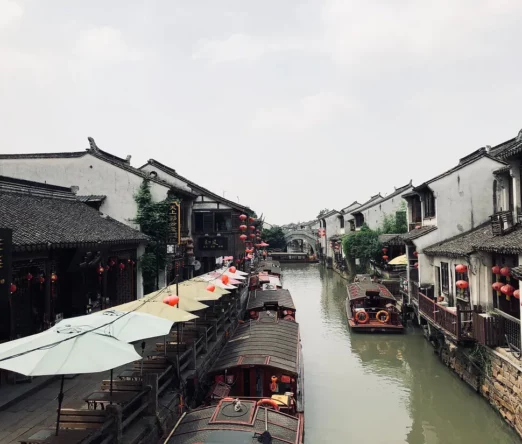I Used to Travel to China a Lot
24 October 2020 | 4 min read

I used to travel a lot in the world. Not only to China, where I have unforgettable memories because of the many times I went there for work.
I remember the magnificent landscapes, the architecture, the smog, the food, and the wonderful people I met and worked with. I also remember the funny experiences on the streets of Beijing, Tianjin, or Harbin, the many misunderstandings, the experience of carrying with me at all times the address of the hotel in Chinese to make sure I can show it to the taxi drivers, etc..
.. And of being photographed often by strangers on the street. Probably because of the way I look, my skin colour, or because I was traveling a lot on my own, I don’t know. We didn’t talk much. We smiled and laughed and took pictures. I must have looked very alien to them. I don’t know how many WeChat photos there are of me from that time!
But I also have many lively memories of North and South Africa, of Asia Pacific, Northern and Southern Europe, West and East, North and Latin America, and funnily my trips didn’t bring me to South America yet… So many places and cultures. Sometimes professionally sometimes for private trips.
I learned a lot about our humanity in those trips. I am amazed by the magnificent diversity of the world. How colourful we are, how diverse. How differently we can think and see the world. How fascinating our personal and collective stories are behind our cultural habits, the patterns behind our languages, the shared memories that impact some social rituals. How obvious things seem to us when we grow up in a particular context and how strange everything looks to us when we don’t belong.
We are fascinated by the surface of what we see. We focus on what is visible to us. People’s skin colour, what they eat and wear, what they do or don’t do, say or don’t say. We are curious, interested, puzzled and even shocked sometimes.
Then we look for codes, want to make sense of what we see, we try to find out about the values beneath those behaviours, try to understand the motivation for some actions and reactions. We look for the rationale behind the cultural differences. We are so obsessed with trying to understand what we see… We lose contact, with the obvious.
Most international teachings are about those differences. There are loads of books about this topic. I used to give intercultural training myself. I used to think that it was useful. And it was, somehow. But I don’t do that anymore.
Looking back, what I actually learned in those trips is that, when we look for differences, we find them, and when we look for common ground, we find it as well. I am amazed at how much more we have in common as humans than we usually see.
In the well-known cultural iceberg, human behaviours and practices are described at the top above the surface of the water, and our beliefs and values are deep at the bottom, way beneath the surface. It surely is true, because we don’t understand and see them immediately. And they explain a lot of our actions. But seeing that is not enough.
We think our intercultural understanding is what brings us together. But even the best intercultural course will not help us come closer to a culture if we don’t get still and connect, not with our intellect but with our soul. We need to spend time with people and listen more deeply to get a sense of who they really are.
Connectedness, and not knowledge, is what brings people together.
Because there is something, we rarely talk about. And it is way more important than understanding a culture. It is that those cultures and the values behind them are actually: made up. Yes, all of them. That’s why it doesn’t help as much as we hope for to know more about them.
Don’t understand me wrong! We can learn more about different cultures if we want to. But in the long run, this is not what really brings us closer together. Especially not if it makes the walls of our prejudices bigger.
The values behind national cultures, religions, organisational or group cultures, etc.. are all human-made, constructed, invented stories of what should or should not be. They are just the surface of who we are and what we are capable of. The top of the iceberg of humanity. They bring some people together and disconnect us from others. They have their roots somewhere in the history of a community or a person, but they are not the roots of who we are, as humanity. Our human centricity brings us to take very seriously everything our heads create, including our cultures.
What is way more important to see is that all the icebergs of this world are made of water. Our cultures are not solid like ice, even if they feel and look that way. They are made of thoughts and are fluid by nature. They are like drops of water that only get solid and iceberg-like in freezing temperatures and then return to their watery essence again when the temperature rises.
If we want to connect, we need to be aware of the fluid nature of our cultural differences, of their made-up form, of the creative shape of their appearance and remember the deeper sense of who we are, as human beings. Fluid. Transient. All actually made of the same material. And already connected, whether we see it or not.
In the last decades, I had the privilege on different occasions to sit together with thousands of people from all over the world in the same room (both physically and online) and engage in meaningful conversations or get quiet. It was amazing how easy it was to sense each other beyond the superficiality of our appearance and of the ideas we have of ourselves and each other.
What happens when our mind gets quiet, when we live out for a moment our made-up differences and our opinions, is that we get in contact with each other at a deeper level. We then literally feel the change in temperature, the warmth that comes from feeling the presence of each other. We experience how much we are all made of the same thing. Some say it is energy. But maybe it is another story. It doesn’t matter really, how we call it.
We can feel deeply connected without understanding someone else’s culture and feel deeply disconnected despite the cultural understanding. The understanding nourishes the intellect. The connection touches the heart. I like both. But knowing what i know now about life, if I had to choose, I would always search the connection of the hearts first. Because that alone can move mountains.
When we look for differences, we see them, when we look for what we all share, we find that as well. In our souls, we are all made of the same stuff.
With Love, Drissia
www.dsh-internationalhr.com / https://soundcloud.com/leadershipbackstage
www.dsh-transformative.com / https://soundcloud.com/transformativecoaching
SHARE THIS ARTICLE
Written by Drissia Schroeder-Hohenwarth
Transformative Coach for Leaders, Teams and Organisations with a fascination for the endless potential of the mind.
More articles from Drissia



